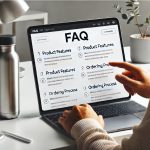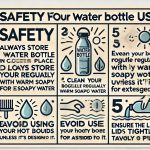In the competitive water bottle industry, standing out among a sea of options is no easy feat. Consumers today are more discerning than ever, often seeking brands that align with their values, offer high-quality products, and provide a unique experience. One of the most powerful tools available to brands to drive growth and increase visibility is a well-executed referral program.
Referral programs encourage existing customers to recommend your products to their friends, family, and networks in exchange for rewards. By leveraging the trust and social influence of your customers, you can build a broader audience and grow your water bottle business in a way that’s organic and cost-effective. However, launching a successful referral program requires careful planning, strategy, and execution to ensure it delivers the best possible results.
Why Referral Programs Are Crucial for Water Bottle Brands
Trust and Authenticity in Recommendations
For many consumers, recommendations from friends or family are one of the most trusted sources of information. Word-of-mouth marketing continues to have a significant impact, especially when it comes from someone a potential customer knows and trusts. Water bottles, being an everyday product, are more likely to be purchased based on personal experiences and positive recommendations. Customers are more likely to trust someone who already uses and loves the product over traditional advertising or marketing.
Referral programs take advantage of this trust by incentivizing your existing customers to recommend your water bottles to others, thereby amplifying your reach. A referral from a satisfied customer is not only effective but also affordable compared to traditional marketing campaigns. As a result, referral programs offer high returns on investment (ROI).
Cost-Effective Customer Acquisition
Unlike paid advertising, referral programs tend to be cost-effective, as they rely on existing customers to do the marketing work. While you do need to provide an incentive to both the referrer and the new customer, this is typically a much lower cost than traditional acquisition methods like digital ads, influencer campaigns, or TV commercials.
Additionally, referred customers are often more likely to stay loyal. Research shows that referred customers are 18% more likely to stay with a brand for at least 3 years. As these customers are typically high-quality leads, you can expect a higher conversion rate compared to other marketing channels.
Increased Customer Lifetime Value (CLV)
Referral programs help increase customer lifetime value (CLV) by bringing in customers who are already familiar with your brand or product. Because referred customers tend to have a higher level of trust, they’re more likely to make repeat purchases and become long-term, loyal buyers. Offering incentives for referrals not only strengthens customer loyalty but also boosts sales over time. The more satisfied customers you have, the more referrals you can generate, creating a self-sustaining cycle of growth for your water bottle brand.
Setting Up a Referral Program for Your Water Bottle Brand
Defining Your Program’s Objectives
Before launching your referral program, it’s essential to define your objectives. Ask yourself what you want to achieve with the program. Is your goal to increase sales? Build brand awareness? Expand into a new market? Your objectives will shape the structure of the program and the rewards you offer.
For instance, if your goal is to increase sales in a specific market, you may want to focus on incentivizing referrals within that market. If you’re trying to increase brand awareness, a program that rewards customers for social media sharing could be more appropriate. Establishing clear objectives ensures that the program is focused and delivers measurable results.
Designing the Referral Program Structure
Once you’ve defined your goals, it’s time to design the structure of the referral program. This includes deciding on key elements like how customers will refer others, what rewards they will receive, and how rewards will be tracked.
Referral Mechanism
You’ll need to make the referral process as simple and seamless as possible. The easier it is for customers to share their referral link, the more likely they are to participate. There are several ways to facilitate this:
- Referral Links: Give customers unique referral links that they can share through email, social media, or text message. When a new customer clicks on the link and makes a purchase, the referrer receives their reward.
- Referral Codes: Allow customers to share referral codes that can be entered during checkout. This is particularly useful for in-store or offline referrals.
- Social Media Integration: Integrating social media sharing options directly into the referral process allows customers to easily share their experiences and links with their followers.
Reward Structure
The rewards you offer should be appealing enough to encourage customers to participate but also sustainable for your business. There are several reward models you can consider:
- Discounts: Offer a discount on future purchases for both the referrer and the new customer. For example, both parties could receive 10% off their next order.
- Free Products: For a higher-value reward, offer a free product (e.g., a free water bottle after three successful referrals). This works well for premium or exclusive products.
- Store Credits: Provide customers with store credit, which can be used for future purchases. This is a great option because it encourages repeat business.
- Tiered Rewards: To keep customers engaged, you can implement a tiered reward system where referrers earn more valuable rewards as they make more referrals. For example, after five successful referrals, a customer might receive a free bottle or a special edition product.
Reward Timing
It’s important to decide when rewards will be issued. Consider whether you will issue rewards immediately after a referral is made or whether you will wait until the referred customer makes their first purchase. Some brands choose to provide rewards upfront as a way to encourage immediate action, while others wait until the referred customer has made a purchase to ensure the program is more sustainable.
Legal and Compliance Considerations
Before launching your referral program, it’s essential to understand any legal and compliance requirements. These may vary depending on your country or the regions you operate in, but here are some general considerations:
- Transparency: Ensure that the referral program’s terms and conditions are clear to participants. Specify the rules for earning rewards, the referral process, and any restrictions (such as a limit on the number of referrals).
- Privacy: Make sure that customer data (such as email addresses) is handled securely. Do not share personal information with third parties without consent.
- Tax Implications: Be aware of any tax implications related to rewards, especially if they are considered taxable income in your jurisdiction.
Promoting Your Referral Program
Announcing the Program to Existing Customers
The success of your referral program hinges on getting your existing customers involved. Start by announcing the program to your current customer base through email newsletters, website pop-ups, and social media. Explain the benefits of the program and how easy it is to participate.
- Email Campaigns: Send out dedicated emails to your customer list, outlining the referral program’s rewards, how it works, and the benefits of participation. Include a clear call to action and a link to the program page.
- Website Promotion: Highlight the referral program on your homepage and product pages. Make it easy for customers to find and sign up for the program. Using banners, pop-ups, and call-to-action buttons can grab their attention.
- Social Media Announcements: Promote the referral program through your social media channels, such as Instagram, Facebook, and Twitter. Consider running contests or giveaways to encourage more referrals.
Encouraging Social Sharing and Word-of-Mouth
To maximize the reach of your referral program, encourage customers to share their referral links or codes on social media. This can be done by offering additional incentives, such as extra points or rewards for sharing the program with a certain number of friends.
- Social Media Sharing Buttons: Integrate easy-to-use sharing buttons into your referral program so that customers can quickly post their referral link on Facebook, Instagram, or Twitter.
- Hashtags: Create a branded hashtag for your referral program. Encourage customers to use this hashtag when they share their experiences or invite others to join the program. This can help build a sense of community and increase visibility.
- Referral Tracking on Social Media: If your program allows for social sharing, ensure that it’s easy to track referrals coming from social media. Many referral programs come with built-in tracking for social shares, which simplifies the process for both you and your customers.
Partnering with Influencers
Partnering with influencers who align with your brand can significantly amplify the reach of your referral program. By having influencers promote your program to their followers, you can quickly expand your customer base and build trust through authentic recommendations.
- Influencer Incentives: Offer influencers special referral incentives for every new customer they refer. Some influencers may prefer exclusive products, while others might want a percentage of sales driven by their referrals.
- Influencer Reviews and Testimonials: Encourage influencers to share their experiences with your water bottles, and offer them referral links or codes that they can share with their audience.
Tracking and Measuring the Success of Your Referral Program
Key Performance Indicators (KPIs) to Track
To evaluate the success of your referral program, it’s essential to track relevant metrics and KPIs. Some key performance indicators to consider include:
- Referral Conversion Rate: Measure how many referred customers actually make a purchase compared to how many people were referred.
- Customer Acquisition Cost (CAC): Calculate the cost of acquiring a new customer through the referral program. This helps you determine if the rewards you’re offering are sustainable.
- Referral Volume: Track how many referrals are made over a given period. This will give you insight into how engaged your customers are with the program.
- Program Participation Rate: Measure the percentage of existing customers who participate in the referral program. This metric helps assess the overall appeal and effectiveness of the program.
Analyzing and Refining the Program
Once the referral program is live, it’s important to regularly analyze its performance and make adjustments as needed. If you notice low conversion rates or a lack of engagement, consider adjusting the rewards, making the program easier to use, or promoting it more effectively.
Testing different aspects of the referral program, such as the reward structure or the type of incentives offered, will help you find the most effective combination for driving growth. Regularly soliciting customer feedback on the program can also help identify pain points or areas for improvement.
Conclusion
Launching a successful referral program for your water bottle brand can significantly boost customer acquisition, build brand loyalty, and increase your overall sales. By offering compelling rewards, promoting the program effectively, and tracking key performance metrics, you can create a referral program that drives sustainable growth for your brand. With the right planning and execution, a referral program can turn your loyal customers into enthusiastic brand ambassadors who help spread the word about your water bottles to new audiences.







